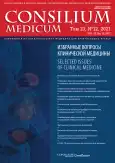Contrast-induced acute kidney injury after computed tomography with contrast media in patients with cardiovascular diseases
- Authors: Vasin A.A.1, Mironova O.I.1, Fomin V.V.1
-
Affiliations:
- Sechenov First Moscow State Medical University (Sechenov University)
- Issue: Vol 23, No 12 (2021)
- Pages: 928-930
- Section: Articles
- URL: https://journals.rcsi.science/2075-1753/article/view/100018
- DOI: https://doi.org/10.26442/20751753.2021.12.201162
- ID: 100018
Cite item
Full Text
Abstract
Aim. To assess the frequency of contrast-induced acute kidney injury (CI-AKI) in patients with cardiovascular diseases (CVD) undergoing computed tomography (CT) with intravenous contrast media.
Materials and methods. In prospective observational study (ClinicalTrials.gov ID NCT04666389) were included 51 patients with CVD undergoing CT with intravenous contrast media administration. The primary endpoint was CI-AKI according to KDIGO criteria [the 25% rise (or 0.5 mg/dl) of serum creatinine from baseline assessed 48–72 hours after administration of contrast media]. There were 51% of women included in the study. The average age was 61.74±1.5. The most frequent cardiovascular disease was hypertension in both men and women – 52 and 39% respectively.
Results. CI-AKI was diagnosed in 2 (3.92%) patients. At the same time, it was not possible to establish statistically significant relationship (p<0.05) between risk factors and the development of CI-AKI.
Conclusion. Cardiovascular diseases may increase the risk of CI-AKI after CT with intravenous contrast media administration. Therefore, it is recommended to evaluate the serum creatinine concentration in such patients.
Full Text
##article.viewOnOriginalSite##About the authors
Andrey A. Vasin
Sechenov First Moscow State Medical University (Sechenov University)
Author for correspondence.
Email: vasin_dr@mail.ru
ORCID iD: 0000-0002-6261-3086
Graduate Student
Russian Federation, MoscowOlga Iu. Mironova
Sechenov First Moscow State Medical University (Sechenov University)
Email: mironova_o_yu@staff.sechenov.ru
ORCID iD: 0000-0002-5820-1759
Cand. Sci. (Med.)
Russian Federation, MoscowVictor V. Fomin
Sechenov First Moscow State Medical University (Sechenov University)
Email: vasin_dr@mail.ru
ORCID iD: 0000-0002-2682-4417
D. Sci. (Med.), Prof., Corr. Memb. RAS
Russian Federation, MoscowReferences
- Bartels ED, Brun GC, Gammeltoft A, Gjørup PA. Acute anriria following intravenous pyelogrnphy in a patient with myelomntosis. Acta Med Scand. 1954;150(4):297-302.
- Mehran R, Nikolsky E. Contrast-induced nephropathy: definition, epidemiology, and patients at risk. Kidney Int Suppl. 2006;100:S11-5. doi: 10.1038/sj.ki.5000368
- Ozkok S, Ozkok A. Contrast-induced acute kidney injury: A review of practical points. World J Nephrol. 2017;6(3):86-99. doi: 10.5527/wjn.v6.i3.86
- Castaldo P, Frascà GM, Brigante F, et al. Low incidence of nephrotoxicity following intravenous administration of iodinated contrast media: a prospective study. Eur Radiol. 2019;29(7):3927-34. doi: 10.1007/s00330-019-06147-2
- Rudnick MR, Leonberg-Yoo AK, Litt HI, et al. The controversy of contrast-induced nephropathy with intravenous contrast: what is the risk? Am J Kidney Dis. 2020;75(1):105-13. doi: 10.1053/j.ajkd.2019.05.022
- Neilipovitz J, Hiremath S, Rosenberg H, et al. CJEM Debate Series: contrast-enhanced imaging should not be withheld for emergency department patients as contrast-induced acute kidney injury is very uncommon. Can J Emerg Med. 2021;23(4):432-6. doi: 10.1007/s43678-021-00126-7
- Kooiman J, Pasha SM, Zondag W, et al. Meta-analysis: serum creatinine changes following contrast enhanced CT imaging. Eur J Radiol. 2012;81(10):2554-61. doi: 10.1016/j.ejrad.2011.11.020
- Aycock RD, Westafer LM, Boxen JL, et al. Acute kidney injury after computed tomography: a meta-analysis. Ann Emerg Med. 2018;71(1):44-53.e4. doi: 10.1016/j.annemergmed.2017.06.041
- Demchuk OV, Sukmanova IA, Ponomarenko IV, Elykomov VA. Contrast-induced nephropathy in patients with acute coronary syndrome: Clinical significance, diagnosis, prophylaxis. Cardiovascular Therapy and Prevention. 2020;19(2):2255. doi: 10.15829/1728-8800-2019-2255
- Kellum JA, Lameire N, Aspelin P, et al. Kidney disease: Improving global outcomes (KDIGO) acute kidney injury work group. KDIGO clinical practice guideline for acute kidney injury. Kidney Int Suppl. 2012;2(1):1-138. doi: 10.1038/kisup.2012.1
- Barrett BJ, Katzberg RW, Thomsen HS, et al. Contrast-induced nephropathy in patients with chronic kidney disease undergoing computed tomography: A double-blind comparison of iodixanol and iopamidol. Invest Radiol. 2006;41(11):815-21. doi: 10.1097/01.rli.0000242807.01818.24
- Park JH, Shin HJ, Choi JY, et al. Is there association between statin usage and contrast-associated acute kidney injury after intravenous administration of iodine-based contrast media in enhanced computed tomography? Eur Radiol. 2020;30(10):5261-71. doi: 10.1007/s00330-020-06897-4
- Andra CA, Khairul A, Arina CA, et al. Contrast induced nephropathy in hypertensive patients after elective percutaneous coronary intervention. IOP Conf Ser Earth Environ Sci. 2018:130(1). doi: 10.1088/1755-1315/130/1/012006
- Mironov OIu, Sivakova OA, Fomin VV. Contrast-induced nephropathy in patients with stable coronary artery disease and 1-year prognosis. Eurasian Hear J. 2020;1685(3):100-5. doi: 10.38109/2225-1685-2020-3-100-105
- Rim MY, Ro H, Kang WC, et al. The effect of renin-angiotensin-aldosterone system blockade on contrast-induced acute kidney injury: a propensity-matched study. Am J Kidney Dis. 2012;60(4):576-82. doi: 10.1053/J.AJKD.2012.04.017
- Peng F, Su J, Lin J, Niu W. Impact of renin-angiotensin-aldosterone system-blocking agents on the risk of contrast-induced acute kidney injury: a prospective study and meta-analysis. J Cardiovasc Pharmacol. 2015;65(3):262-8. doi: 10.1097/FJC.0000000000000189
Supplementary files







